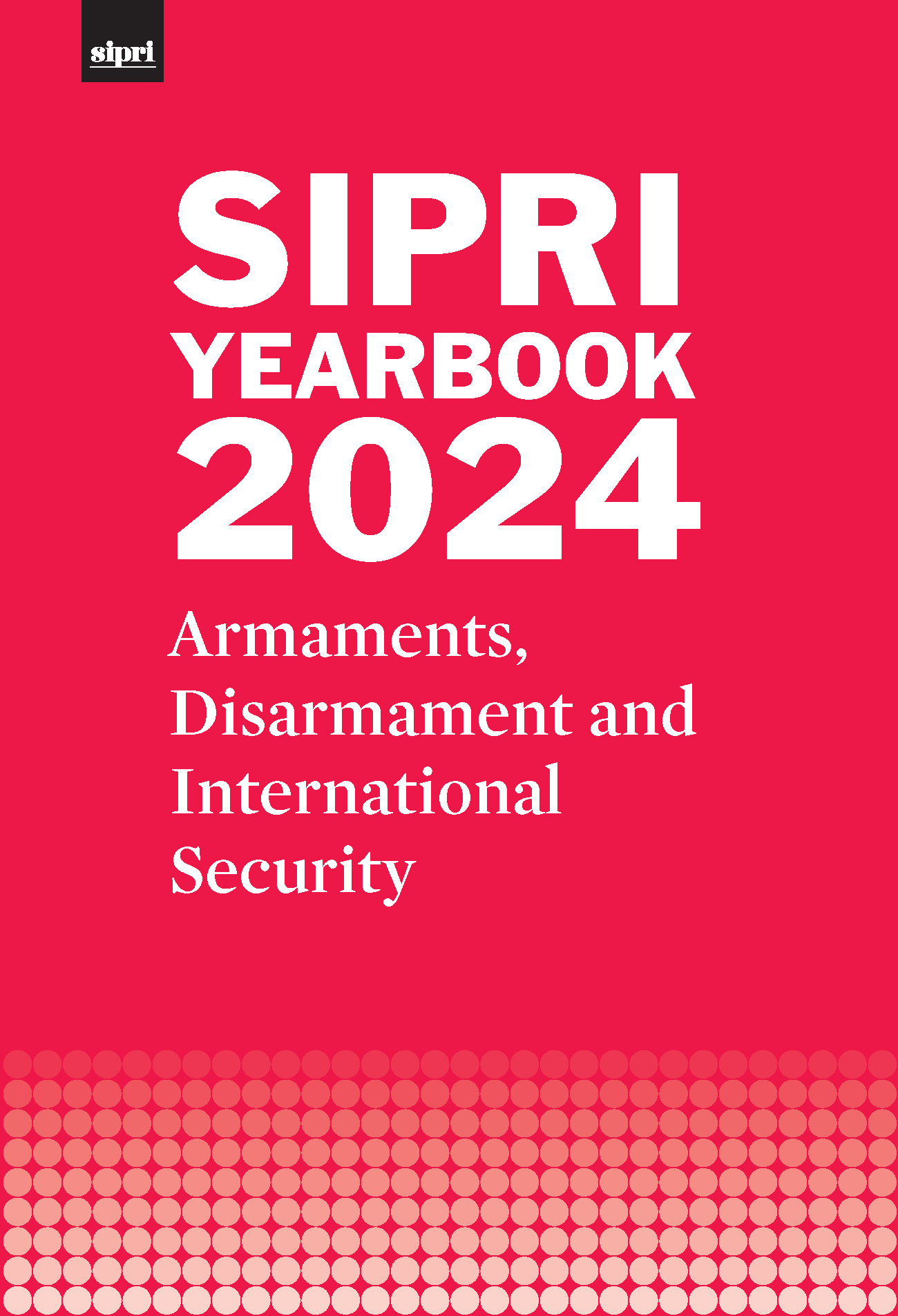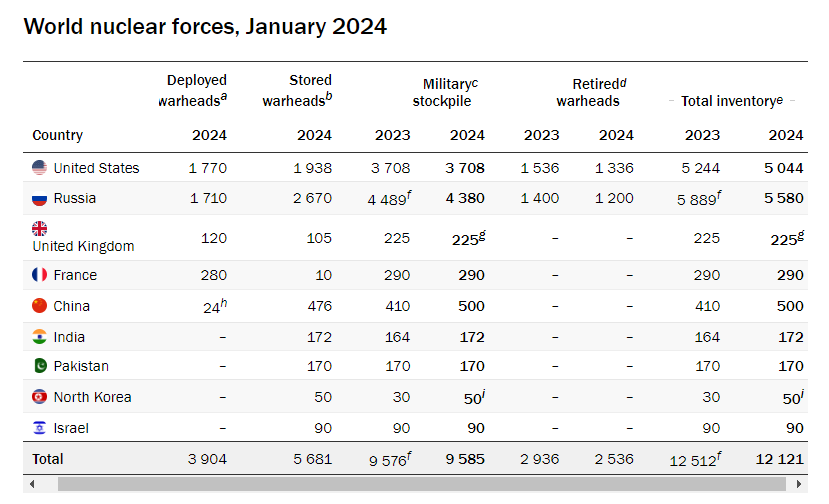
The Stockholm International Peace Research Institute (SIPRI) launched its Yearbook 2024 on 17 June. The yearbook contains the annual assessment of the state of armaments, disarmament, and international security.
Summarised excerpts from the yearbook:-
Conflict Trends
Although the number of states experiencing armed conflicts fell from 55 in 2022 to 52 in 2023, the estimated number of conflict-related fatalities worldwide rose from 153,100 in 2022 to 170,700 in 2023, reaching the highest level since 2019.
In 2023, four conflicts were categorised as major armed conflicts (i.e. conflicts involving 10,000 or more conflict related fatalities in the year), one more than in 2022: the civil wars in Myanmar and Sudan, and the Israel–Hamas and Russia–Ukraine wars.
The number of high intensity armed conflicts (i.e. conflicts involving 1000–9999 conflict related fatalities) also increased, from 17 in 2022 to 20 in 2023.
The Russia–Ukraine war continued throughout 2023 at a high cost to both sides. Russian air attacks continued, and Ukraine began to reply in kind, although not on the same scale. Both sides sought and received ammunition and weapons from their allies. There were no formal Russian–Ukrainian peace talks during the year, and the one noteworthy diplomatic success—the 2022 Black Sea Grain Initiative—unravelled in 2023.
In contrast to the stalemate in Ukraine, in September 2023, Azerbaijan secured a decisive victory in its long running conflict with Armenia over Nagorno-Karabakh.
High intensity armed conflicts continued in Iraq, Syria and Yemen throughout the year.
Israel responded to the events of 7 October (the killing of over 1000 civilians and more than 350 Israeli soldiers and police, and the capture of around 240 hostages) by declaring a state of war for the first time since 1973. By the end of the year, more than 22,000 Palestinians had been killed in the ensuing air strikes or ground operations by Israel. Houthi forces in Yemen, claiming support for the Palestinians, started to attack commercial shipping in the Red Sea, prompting Western powers to dispatch warships to the area to address the threat.
SubSaharan Africa remained the region with the most armed conflicts, although many were low intensity conflicts (involving fewer than 1000 conflict-related fatalities), and levels of violence fluctuated considerably. There were decreases in conflict related fatalities in several countries experiencing high intensity armed conflict, including the Democratic Republic of the Congo, Ethiopia, Nigeria and South Sudan. However, there were notable increases in conflictrelated fatality rates elsewhere, including in Sudan (+537 per cent compared with 2022), Burkina Faso (+100 per cent) and Somalia (+28 per cent).
The fighting that erupted in Sudan on 15 April 2023 between forces led by rival military generals triggered a humanitarian crisis and resulted in an all-out civil war.
In the Sahel, a coup in Niger and a decision by Mali to expel United Nations peacekeepers added to regional tensions.
The Americas is the only region not to have had a major armed conflict in 2018–23. The two countries in the region with the highest number of conflictrelated fatalities—Brazil and Mexico—primarily faced criminal rather than political violence in 2023. Criminal gang related violence also escalated significantly in Haiti during the year.
Despite the ongoing civil war in Myanmar, the overall conflictrelated fatality rate for Asia and Oceania more than halved between 2021 and 2023. This was partly due to a continuing decline in conflictrelated fatalities in Afghanistan following the return to power of the Taliban in 2021.
Military Spending
Estimated global military expenditure rose for the ninth consecutive year in 2023, surpassing $2.4 trillion, driven by the Russia–Ukraine war and broader geopolitical tensions.
The 6.8 per cent increase in total military spending in 2023 was the largest rise since 2009, pushing estimated world spending to the highest recorded level.
As a result, the global military burden {world military expenditure as a share of world gross domestic product (GDP)} rose to 2.3 percent.
Governments allocated 6.9 per cent of their budgets to the military or $306 per person.
Estimated military spending increased across all five geographical regions for the first time since 2009.
Spending by African countries rose the most (by 22 percent in 2023), while the smallest increase was in the Americas (2.2 percent).
The United States remained by far the largest military spender in the world. Its $916 billion expenditure was more than the combined spending of the nine other countries among the top 10 spenders and 3.1 times as large as that of the second biggest spender, China.
The trend for increased military spending by European states in response to Russia’s full scale invasion of Ukraine gained traction in 2023. 39 of the 43 countries in Europe increased military spending. The 16 per cent surge in total European expenditures was driven by a 51 per cent rise in Ukrainian spending and a 24 per cent rise in Russian spending, as well as by 10 of the 28 European members of the North Atlantic Treaty Organization (NATO) reaching or surpassing the 2 per cent of GDP spending target in 2023.
Estimated military expenditures in Asia and Oceania rose for the 34th consecutive year. Half of the regional total consisted of spending by China, which grew by 6.0 per cent to reach $296 billion in 2023. China’s spending influenced spending decisions in neighbouring countries and the broader region: in Japan, for example, spending rose by 11 per cent, the largest year-on-year spending increase since 1972.
Estimated military spending in the Middle East grew by 9.0 per cent in 2023, with increases in all three of the biggest spenders in the region: Saudi Arabia, Israel and Turkiye. The Israel–Hamas war was the main driver for the 24 per cent increase in Israel’s military expenditure.
Arms Transfer
Suppliers of Major Arms
In 2019–23, 66 states exported arms, but most were minor exporters. The 25 largest suppliers accounted for 98 per cent of the total volume of exports, and the top five (the United States, France, Russia, China, and Germany) accounted for 75 per cent.
The USA’s share of global exports has increased in recent years while Russia’s share has decreased. In 2019–23, the USA’s arms exports were 17 percent higher than in 2014–18, and its share of the global total increased from 34 to 42 percent. In contrast, Russia’s arms exports decreased by 53 per cent, and its share of the global total dropped from 21 to 11 per cent.
France’s exports rose by 47 percent between 2014–18 and 2019–23, making it the second largest exporter of major arms in 2019–23.
Known plans for future deliveries of major arms strongly indicate that the USA will remain unchallenged as the largest arms exporter in the coming years and that France will consolidate its position in second place. They also indicate that Russia’s arms exports may reduce even further, while some of the other current top 10 exporters are likely to remain steady or increase.
Recipients of Major Arms
In 2019–23, 170 states imported arms. The five largest importers were India, Saudi Arabia, Qatar, Ukraine, and Pakistan, accounting for 35 percent of total arms imports.
Asia and Oceania received the largest volumes of major arms in 2019–23, accounting for 37 percent of the total, followed by the Middle East (30 percent), Europe (21 percent), the Americas (5.7 percent), and Africa (4.3 percent).
Between 2014–18 and 2019–23, the flow of arms to Europe increased by 94 per cent, while flows to all other geographical regions decreased: Africa (−52 per cent), Asia and Oceania (−12 per cent), the Middle East (−12 per cent) and the Americas (−7.2 per cent).
Many of the 170 importers are directly involved in armed conflict or in tensions with other states where the imported major arms play an important role.
Moreover, many exporters are direct stakeholders or participants in at least some of these conflicts and tensions, which partly explains why they are willing to supply arms, even when the supply seems to contradict their stated arms export policies. It is also noteworthy that, for most suppliers, arms exports are only a small part of the financial value of their total exports.
Stockholm International Peace Research Institute (SIPRI)
The Stockholm International Peace Research Institute (SIPRI) is an independent, international think tank based in Stockholm that provides research, data, and analysis on arms control, disarmament, military expenditure, and armed conflict. It was founded in 1966 by Alva Myrdal and Tage Erlander. SIPRI’s work is intended to help researchers, policymakers, and the public understand the state of the arms industry and the preconditions for a stable peace.
SIPRI’s work is based on open sources and includes:
- Databases. SIPRI’s Arms transfers, Arms industry, and Military expenditure databases provide data on nearly every country in the world.
- Documents. SIPRI provides documents on arms embargoes since the 1950s and national reports on arms export controls.
- Analysis. SIPRI researchers analyse the data to identify trends and potential impacts on global security.
Suggestions and value additions are most welcome.
For regular updates, please register here:-
References and credits
To all the online sites and channels.
Disclaimer:
Information and data included in the blog are for educational & non-commercial purposes only and have been carefully adapted, excerpted, or edited from reliable and accurate sources. All copyrighted material belongs to respective owners and is provided only for wider dissemination.


